Publications detailing how to survive any given situation pop up everywhere. Some are serious and fearful, others practical and common sense, and then there are those tongue-in-cheek and humorous. Wilderness Survival Guide (2012); The Prepper’s Urban Survival Guide to Los Angeles (2016); A Survival Guide to Archival Research (2004); The Zombie Survival Guide (2003); I’m Dreaming of a Black Christmas: A Holiday Survival Guide (2006) are a mere smattering of works promoting tactics to pull through in life.
The Smithsonian Libraries holds a range in this genre, collected for varying reasons. Some are for assisting our researchers in the field, helping staff negotiate work, or providing information to our readers. Some are relevant to a museum’s collection, or as a reflection of a culture or period—that is, an artifact. Examples of this category in the collections of our branch libraries include: Bushcraft: A Serious Guide to Survival and Camping (1972); The Bad Attitude Survival Guide: Essential Tools for Managers (1998); Who Gives A Gigabyte? A Survival Guide for the Technologically Perplexed (1999); Just in Case: A Passenger’s Guide to Airplane Safety and Survival (1984); Making Native American Hunting, Fighting, and Survival Tools (2004); The Busy Women’s Survival Guide: Making Time for Yourself and Others (1992); and Permission, A Survival Guide: Blunt Talk About Art as Intellectual Property (2006).
The Libraries has one of the earliest volumes of survival tips: The Art of Travel, or, Shifts and Contrivances Available in Wild Countries by Francis Galton. The book was first published in 1855 after the Englishman’s return from an arduous expedition in South West Africa (now Namibia) (link). Galton explains how to handle elephants and provides helpful hints about avoiding cobras and suggestions for a safari outfit. A guide for Victorian adventurers and armchair travelers as well, the work proved popular. One avid reader was the explorer (among many other things) Sir Richard Francis Burton. Galton had already planned further editions with the first, in an early attempt at “crowdsourcing.” He wrote in the Preface:
The Author of this volume, which is intended as a Manual for all who have to rough it, whether they be explorers, emigrants, missionaries, or soldiers, earnestly invites such of his readers as can speak from actual experience of the matters on which it treats, to furnish him with remarks, sketches, and corrections, as, in the event of a revised edition being published, they would be of the greatest value to him.
The Art of Travel indeed was published many times, up to the fifth edition in 1872, updated with information about travels in the Arctic region, and it is still is in print. The Biodiversity Heritage Library has digitized the 1860 edition. The book makes for a fun read with its references to Mr. Darwin (Charles was a half cousin) and Captain Bligh, and reflects the lively and curious mind of a progressive thinker. Like his contemporary Burton, Galton had many professions: sociologist, anthropologist, inventor, and meteorologist are a few. The author coined the terms “eugenics” and “nature versus nurture.” The Smithsonian has several of his publications, including Fingerprints of 1892, a classification system that proved helpful to forensic science.
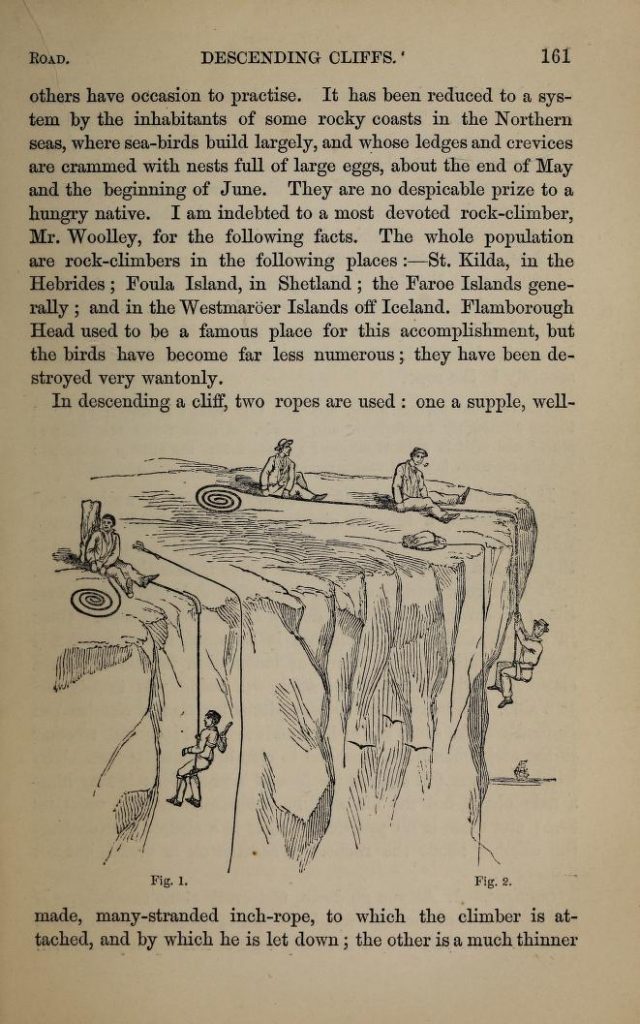
Galton’s The Art of Travel set off a trend that grew over the following decades, as society confronted new unknowns and horrors caused by wars and modern technology.
Small Boat Navigation, by F. W. Sterling, who had served as a lieutenant commander in the United States Navy, describes traditional techniques of piloting, dead reckoning and nautical astronomy for those cast adrift. His book is for those who would find themselves in a lifeboat making a short passage, often in sight of land. It was first printed during the Great War (1916) but alas, still relevant, was re-issued throughout the 1930s and ‘40s.
Tremendous new challenges marked the period of World War II. There is much for historians to study in the books from this time, including different approaches and their effectiveness, and, in addition, what guides were issued by what branch of the Armed Forces and Government and what were their greatest concerns. The vast Pacific Ocean theater of war required previously unimagined expertise in survival skills. Such handbooks are culturally important and reflect the challenges and fears of fighting in little-known and -understood parts of the globe, in harsh environments and over immense areas. (Paralleling that global war-era are those of more recent time. The Millennium and the post-September 11th world ushered in several titles. The Hippy Survival Guide to Y2K (1999), Survival Skills of Native California (1999), and Homeland Security: A Comprehensive Guide to Understanding, Preventing and Surviving Terrorism (2005) are examples of these anxious times).
The Smithsonian collections of war survival guides are significant survivors themselves. Written and produced for pressing reasons and under extraordinarily tight deadlines, they were cheaply printed and often didn’t last long (as they were not intended to), particularly in the extreme environments and conditions they were exposed to. Although containing information best absorbed before disaster struck, the manuals were designed to be kept in a pocket or in a knapsack and used in survival mode. How to Abandon Ship (1942), based on interviews with survivors from a torpedoed tanker, emphasizes steps to stay alive in a lifeboat. A booklet for finding useful plants and sea creatures (and what to avoid) is Food is Where You Find It: A Guide to Emergency Foods in the Western Pacific (1944). As were many of the war period, it was written for those surviving a plane crash or shipwreck. Another of the same year, also pocket-size, was Army Air Forces Survival on Land, at Sea, prepared by the Arctic, Desert and Tropic Information Center (1944). In a class amongst itself is Harold Gatty’s The Raft Book (link). After serving in Australia at the beginning of the war, The Tasmanian-born Gatty came back to the United States and Washington in 1943. His survival guide was written for the US Army Air Corps and soon became standard issue for all Allied aircrews in the Pacific Theater. Trained as a mariner, the pioneering aerial navigator (Gatty had accompanied Wiley Post on the record-setting around-the-world flight of the Winnie Mae), who was extremely well-read and knew much of the innumerable islands and coral reefs of the Pacific, was ideally suited for the task. Gatty wrote the manuscript and drew up all the star carts and maps for The Raft Book in just four months. Curiously, it was not Government-issued but privately printed by a New York press known for its museum exhibition catalogs and illustrated books, George Grady. Gatty and his wife, Fena Gatty, held the copyright.
In a class amongst itself is Harold Gatty’s The Raft Book (link). After serving in Australia at the beginning of the war, The Tasmanian-born Gatty came back to the United States and Washington in 1943. His survival guide was written for the US Army Air Corps and soon became standard issue for all Allied aircrews in the Pacific Theater. Trained as a mariner, the pioneering aerial navigator (Gatty had accompanied Wiley Post on the record-setting around-the-world flight of the Winnie Mae), who was extremely well-read and knew much of the innumerable islands and coral reefs of the Pacific, was ideally suited for the task. Gatty wrote the manuscript and drew up all the star carts and maps for The Raft Book in just four months. Curiously, it was not Government-issued but privately printed by a New York press known for its museum exhibition catalogs and illustrated books, George Grady. Gatty and his wife, Fena Gatty, held the copyright.


The variety of aircraft flying over vast distances of ocean, not to mention the destruction at Pearl Harbor, led to problems of survival and rescue. In January 1942, an aviator crew failed to return to their aircraft in the south Pacific. While they were inflating their raft, the plane suddenly sank leaving them with no provisions and navigational aids. They survived by sheer luck; others did not. Gatty knew that anyone making it from a plane into a lifeboat likely would not have much in the way of provisions and instruments, if anything at all.
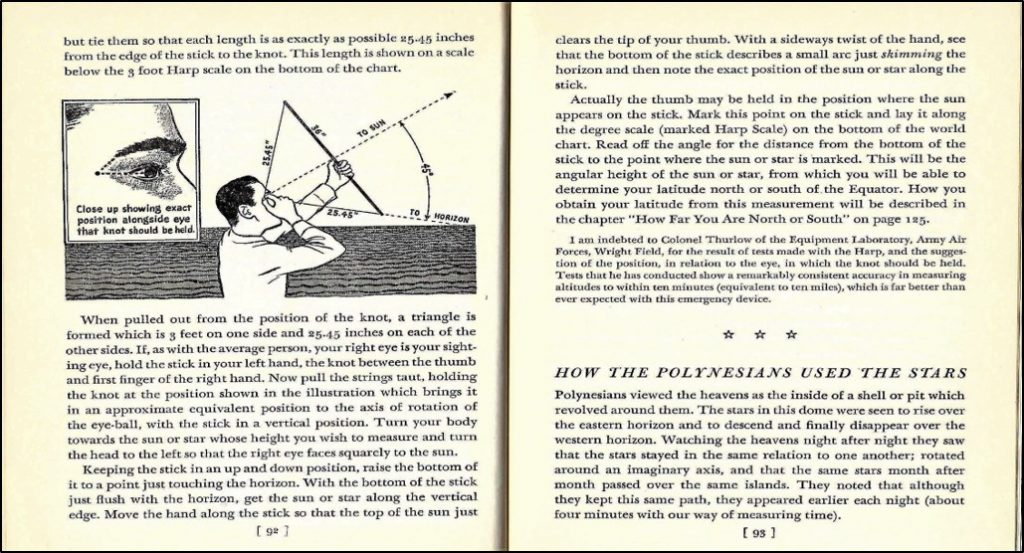
Of all the survival manuals that came out early in the war, The Raft Book stands out, from its cover on in. It is mostly of Polynesian navigation techniques. Gatty states that the reader’s forefathers used five senses to travel great distances on the oceans and without modern equipment, so the reader could too and do so anywhere in the world. Also what makes the The Raft Book unique is everything is positive in tone, practical and encouraging, the author knowing, if one panics or despairs all is lost. The ocean is portrayed not as a hostile environment but is teeming with life and has been traveled for ages. There is much on Polynesians’ ability to cross thousands of miles of unchartered seas and to read nature’s signs.
Another of the most remarkable guides of the period was produced by the Smithsonian: Survival on Land and Sea (link). The volume was “Prepared for The United States Navy by the Ethnogeographic Board and the Staff of The Smithsonian Institution.” It was an impressive undertaking, produced within just three months. Smithsonian historian and archivist Pamela M. Henson details this booklet as well as the Institution’s wartime role in the fascinating chapter “The Smithsonian Goes to War: The Increase and Diffusion of Scientific Knowledge in the Pacific,” a section in the not-easily found Science and the Pacific War (edited by Roy M. MacLeod, 1999) (link). First published in 1943 and then again in 1944, about one million copies of Survival on Land and Sea were distributed to servicemen in the Pacific Theater. As the cover title states, it was “not for sale.”
Survival on Land and Sea is a record and great achievement for the Smithsonian during the challenging war years. While the Ethnogeographic Board was set up as a clearing house of information and to coordinate efforts by the Smithsonian, the National Research Council, American Council of Learned Societies, and the Social Research Council, the Institution provided most of the information and financial support. The Board was coordinating a vast range of geographical knowledge, mobilizing scholars for the global war. There was nothing comparable published in Europe.
Drawing on the expertise of entomologists, herpetologists, botanists, malacologists, geographers, and anthropologists, among other specialists of the Smithsonian, the Introduction states that the publication was “written by men who have actually lived in jungles, deserts, and in arctic regions.” Survival on Land and Sea is a succinct compendium in 187 pages of how to overcome any number of life-threatening situations with practical steps. There are maps on the inside of the covers and numerous line illustrations and diagrams.
In contrast is Jungle, Desert, Arctic Ocean Emergencies, issued by the United States Army Air Forces in 1944 (link). As related in Judith Heimann’s The Airmen and the Headhunters: A True Story of Lost Soldiers, Heroic Tribesmen and the Unlikeliest Rescue of World War II (2007; link), the Emergencies handbook was found to be sorely lacking. Survivors of a military plane crash in a Borneo jungle, scavenging what they could from the wreckage, found a copy of the booklet that had little application to their situation: “GOOD FOOD AND GOOD WATER are fairly plentiful in the jungle if you know where to look for them” without much in the way of suggestions on how to find these vital resources. The text does say “Anything that you see monkeys eat, you can eat.”

The Smithsonian’s Survival on Land and Sea tries to strike a reassuring tone, unlike many other war survival guides, and sometimes succeeds, such as declaring the “greatest obstacle that will confront you in the wilderness or at sea is fear of the unknown.” As the survivor overcomes challenges, they will find they are doing well and they just need to “remember that many men, and women too, have already undergone such experiences and have come through.” The reader can too.
At sea, the “waterproof” (really, water-resistant at best) book instructs how to avoid exposure, procure food and water, and navigate without instruments in a lifeboat. Marine mammologists provided the opinion that sharks are not much of a threat but should be avoided. If sharks rub against the raft, it is “to scratch off sea lice rather than as an attempt to overturn the boat.” If nearby whales are bothersome “two pieces of metal struck together under water may drive them away” while splashing may cause sea mammals to investigate.
A survival booklet, Shark Sense (1944; link), is a study in contrast to the Smithsonian handbook. It states at the onset: “Scientists have not dignified the breed with a great deal of intensive study.” It is of the many “Sense” manuals issued by the Naval Operations Aviation Training Division of the U.S. Navy and presents information in comic-book format. There are telling of tales and superstitions, and reassurance that a shark attack is a very rare occurrence. But among the entertainment, there is some practical advice: “The main hurdle to take concerning sharks – should you be adrift in a life jacket or rubber boat in shark-infested waters—is the mental hazard.”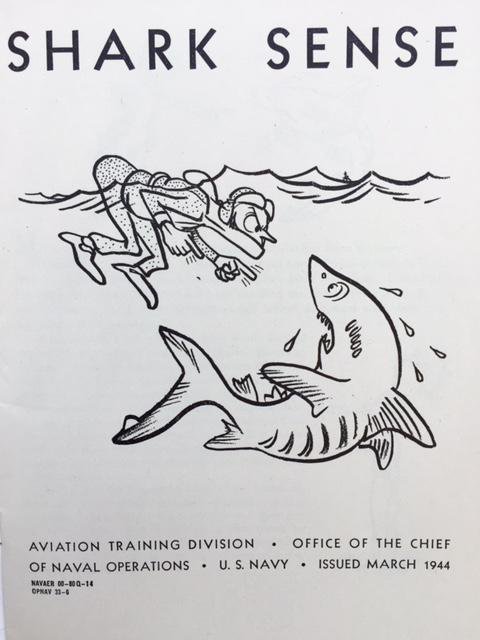
For those stranded on remote islands, the Smithsonian’s Survival on Land and Sea states that natives will help and provides information for drinking and eating in the tropics, such as identifying food plants and how to find mollusks on the beach and noting which ones are dangerous to ingest. The Arctic and desert regions have separate sections, including ailments that might be incurred there. Survival on Land and Sea tries to be humorous in the last section about adapting to the United States after wartime experiences and victories. It ends with asking the survivor to remember that “the best way to understand the Americans is to settle down and actually live with them. They are really a very friendly people despite the apparent ferocity of their handshakes and their violent back-slapping. They mean well. Remember their civilization is much younger than that of Europe and Asia.” This perhaps set the trend of tongue-in-cheek survival guides that are so numerous in the present day.
From a copy in the Smithsonian Libraries, Survival on Land and Sea has been digitized in its entirety by the Biodiversity Heritage Library. Read it here. Not merely a relic from the war and record of the Smithsonian’s considerable efforts, this small book has stood the test of time; crucial information should you find yourself without GPS guidance and in unfamiliar terrain.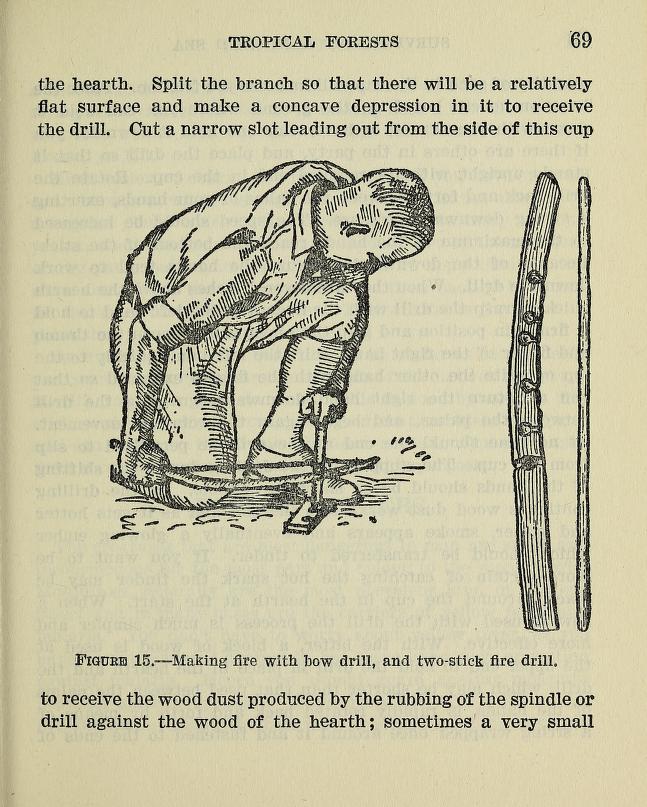

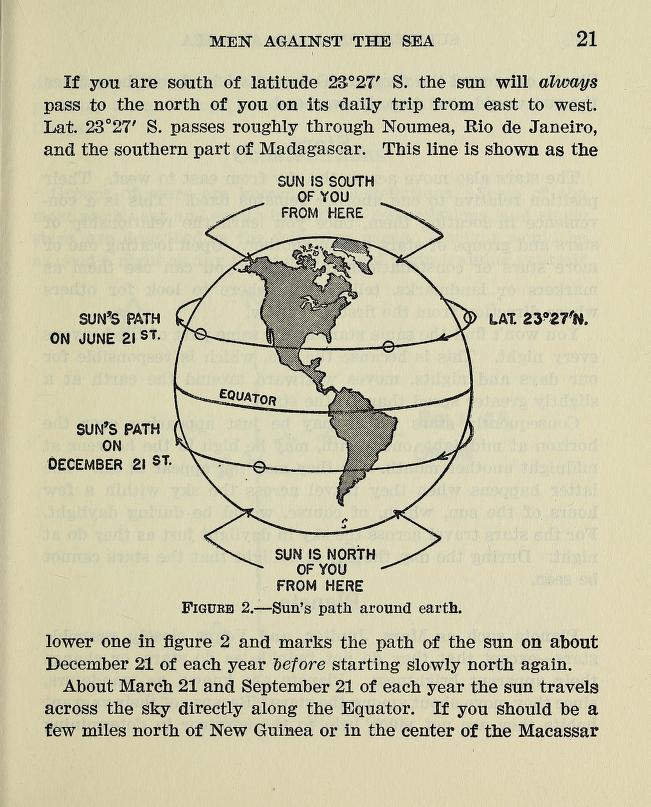


Be First to Comment